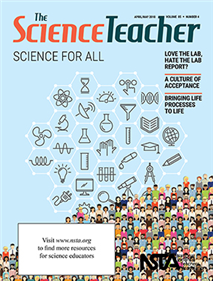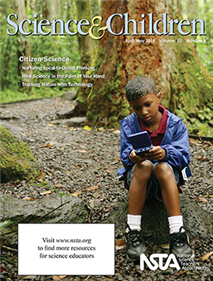All Resources
Journal Article
Practicing “Science for All” means acknowledging and including lesbian, gay, bisexual, and transgender students in the classroom...
Journal Article
Love the Lab, Hate the Lab Report?
Implementing an “intervention” lab report format that even struggling students will complete....
Journal Article
Bringing Life Processes to Life
Modeling protein synthesis in a language all students can understand....
Journal Article
A project-based learning activity to determine how best to redevelop the site of a demolished shopping mall....
Journal Article
Editor’s Corner: Science for All
The Science Teacher’s editor shares thoughts on the current issue....
Journal Article
Focus on Physics: The Slowing of Light in Glass
This column helps teachers build an understanding of physical principles. This month's column discusses energy transfer....
Journal Article
The Idea Bank provides tips and techniques for creative teaching, in about 1,000 words. As students use increasingly diverse internet sources, it becomes hard to tell whether their answers are truly original. A general solution to this dilemma is to...
Journal Article
Career of the Month: Biomedical Engineer
This column shares interviews with professionals using science in the workplace. This issue describes Robert Greenberg's career path to becoming a biomedical engineer....
Journal Article
Right to the Source: An Early Attempt At Flight
Exploring science and history with the Library of Congress. This issue discusses Jacob Degen’s 1807 drawing of the “Flugmaschine.”...
Journal Article
Real Science in the Palm of Your Hand
A framework for designing and facilitating citizen science in the classroom...
Journal Article
Tracking Nature With Technology
First and fourth graders collaborate on a citizen science project to locate and research animals found in their school yard....
Journal Article
Nurturing Local-to-Global Thinking
Third graders explore the world with technology and citizen science, plus an engaging reading and exercise component!...
Journal Article
Fifth graders practice data collection as they examine soil....
Journal Article
Students act as stewards of the environment and learn valuable skills in the process....
Journal Article
Editor’s Note: Citizen Science
Science and Children’s editor shares thoughts regarding the current issue....
Journal Article
The Poetry of Science: Science Is Us!
Building literacy in playful, meaningful ways. This month discusses a poem in relation to citizen science....
Journal Article
The Early Years: Introducing Children to Phenology
This column discusses resources and science topics related to students in grades preK to 2. This issue shares an activity meant to provide children with the experiences of collecting data by making observations in nature over time and connecting with...
Journal Article
Formative Assessment Probes: Uncovering Students’ Ideas About Watersheds
This column focuses on promoting learning through assessment. Water-quality monitoring engages students in learning about watersheds and watershed stewardship. Before introducing the concept of a watershed, find out whether your students have formed...
Journal Article
Teaching Through Trade Books: Beneath Our Feet
This column includes activities inspired by children’s literature. Through the activities in this month’s column, younger students can understand how changes on Earth occur over time and that humans have an impact on Earth systems. Older students...
Journal Article
Teaching Teachers: Learning From Failure
This column enhances the repertoire of preservice and inservice teachers. This month's article includes insights from a university and STARBASE ONE partnership program....
Journal Article
Science 101: How Does a Thermos “Know” to Keep Hot Liquids Hot and Cold Liquids Cold?
This column provides background science information for elementary teachers. This issue discusses heat transfer....
Journal Article
This column shares exercises to challenge content knowledge. This issue presents a new challenge and answers the A Faucet Phenomenon challenge from last month....




